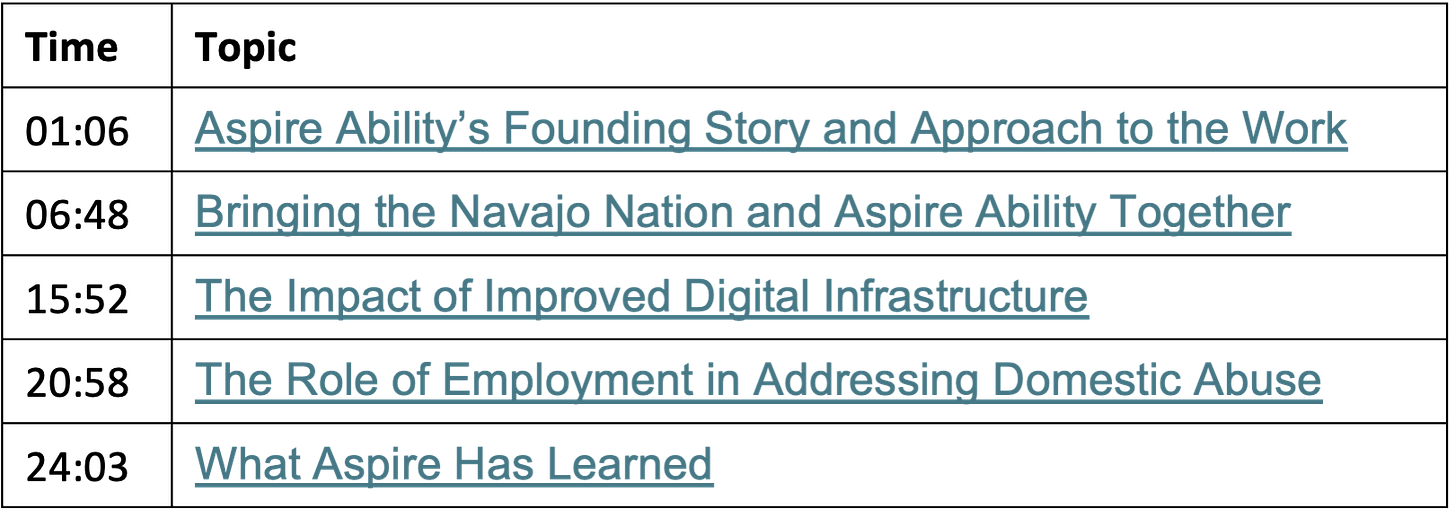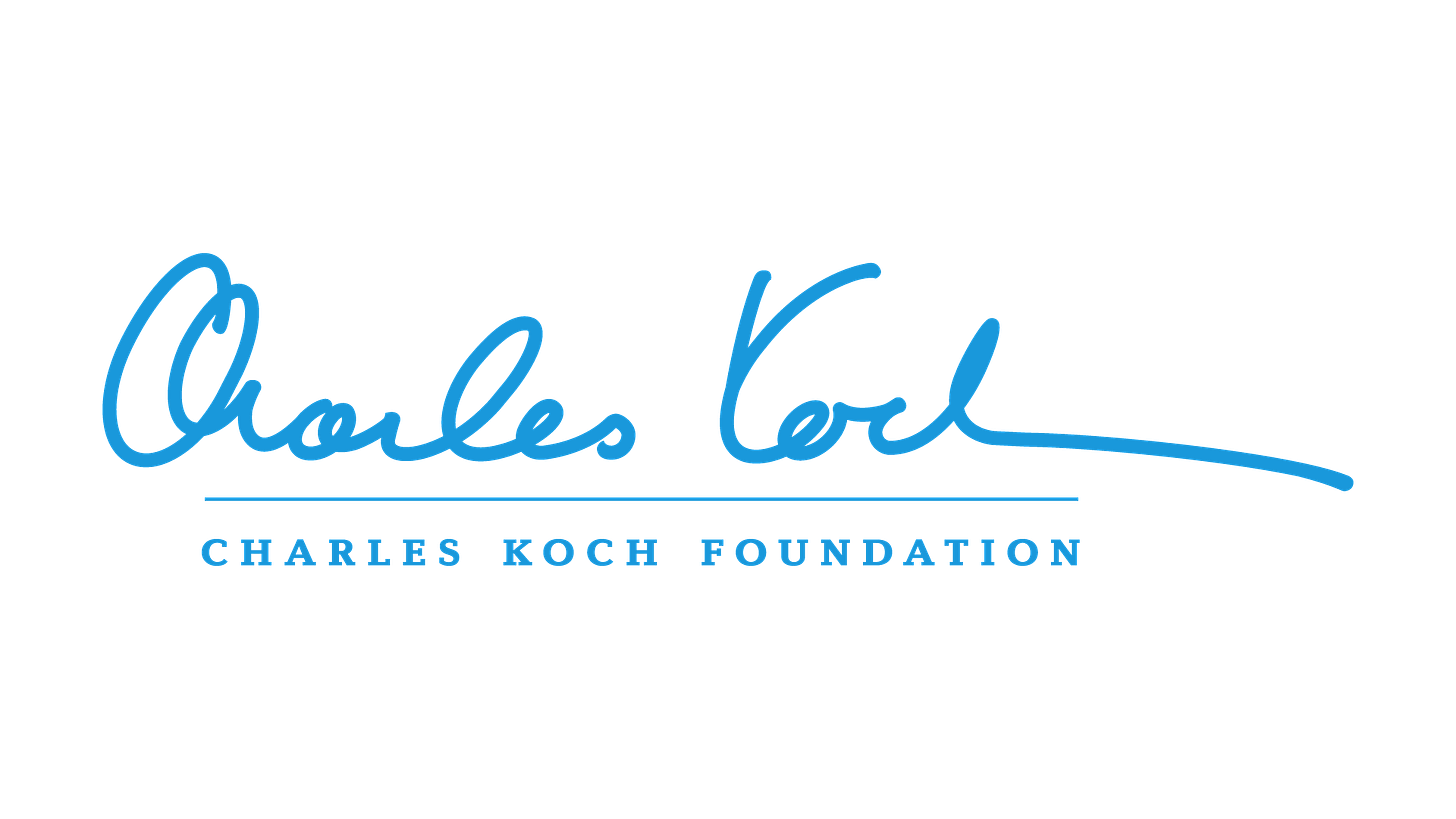In partnership with the Navajo nation, Aspire Ability is getting tribe members plugged into opportunity. How are they doing it? Investments in digital infrastructure + innovative workforce solutions are a big part of the answer.
I sat down with Aspire Ability’s CEO, John Mott, and head of policy, Moroni Benally to learn how the nonprofit is building access to good jobs through remote work. We discussed connecting necessary stakeholders across sectors, the importance of precise skills training, and the downstream benefits of employment. And we talked about how none of the moves they’ve made would have been possible except for a real bottoms-up approach that rooted them on the ground and in the community.
Michael Horn:
Welcome to the Future of Education, the show where we are dedicated to a world in which all individuals can build their passions, fulfill their potential, and live a life of purpose. To help us think through those qualities today and those aspirations… I'm tremendously excited for our two guests. One of whom I've known for several years, he's none other than Jon Mott, currently the founder and CEO of Aspire Ability. Jon, good to see you.
Jon Mott:
Good to see you. Thanks for having us.
Michael Horn:
Absolutely. And the other is a new friend, Moroni Benally. He is a community manager at Aspire Ability, living with the Navajo Nation and supporting the work of Aspire Ability there. We will talk more about that shortly. But Moroni, welcome. Thanks for joining us.
Moroni Benally:
Thank you, Michael.
Aspire Ability’s Founding Story and Approach to the Work
Michael Horn:
Yeah, you bet. So let's get into it. Jon, start with you. Just give us the founding story behind Aspire Ability, your journey to founding it, and what you all do now there.
Jon Mott:
Yeah, I've been in higher ed and adult ed and corporate ed for my whole career across working at Brigham Young University, corporations like TD Ameritrade, and edtech companies like learning objects. About five years ago, having gone through all of these different versions of trying to help people get to better career paths, it just kind of struck me. My training and background is as a political scientist. So I've just been thinking about this as a systemic problem. You've got job seekers, employers, education providers, and they don't connect. So that was the whole purpose of Aspire Ability, to try to get better connections primarily between employers and education providers to make sure that educational programs actually aligned with jobs in the job market. We've been working on that in a variety of different ways over the last five years. And, over the last year and a half, two years, we've been focused on working on that problem in a specific community. If you try to change all of that for the whole world all at once, not gonna happen... But if you can work with a community where you can say, okay, in this case, it's with the Navajo Nation, saying, okay, we know who the employers are, we know there are two tribal colleges, we know who the job seekers are. Let's work on getting the jobs more clearly defined so that the schools can provide upscaling paths. Then we can message that to job seekers and get a better alignment between what are often disconnected points in a three-sided market.
Michael Horn:
Yeah, so let's stay with that. Jon, before we go to the Navajo Nation, and Moroni, before I bring you in, I'm just curious because that approach you just talked about sounds like what the sponsor of this series, the Charles Koch Foundation, and I know a big sponsor of yours, the Charles Koch Foundation, would talk about—this principle of bottoms-up, really solving the problem in a specific area rather than imagining a top-down, one-size-fits-all way about it. So just talk to us about what you've learned and what this work really looks like, engaging these three very different stakeholders in what's really a community talent marketplace.
Jon Mott:
Yeah, absolutely. There's been tremendous work done by lots of our colleagues and friends and people we know in this space to create taxonomies of jobs—what are the skills required for job A, job B? And that's really important foundational work in this space. But what we've discovered is, when you get to a specific job at a specific company, these taxonomies in the sky all of a sudden don't matter. It's like, okay, that's nice to know what a cybersecurity analyst is in general practice, but what about here at my financial services company? One of the keys has been getting to the last mile or the last hundred feet. What does it mean—what skills or proficiency level for those skills are required for this job at this company, maybe even on this team within that company? It's that hyper-localization of skills mapping that's become really critical. And then on the flip side of that, how do you help schools see that yes, there is a core foundation of skills for every job or career path, but then there are—you do need to provide some way to at least expose people to, okay, there's cybersecurity, but here's how it's different in fintech versus healthcare versus education, and really helping people make that last mile connection to a job.
Michael Horn:
Just to stay with you for one more moment on that. It sounds like you probably have to get pretty deep with the companies then, because they might not know the answer to that, I'm assuming.
Jon Mott:
100%. You know, we worked with a very, very large company that everybody would recognize the name. They had five postings for the same job at the same time on the same team that were all different. Because what happens? Hiring managers write the job postings, HR puts them up, they get interviewees to come in. But if the company itself can't agree on what the job is, it's pretty hard to tell the school, hey, here's what we need. So we do dig in deep, looking at the documentation for the job, but then talking to stakeholders, talking to incumbents, really helping the employer get aligned around, yes, we agree, this is what the set of knowledge, skills, and abilities are required for this job. And here's how we're going to measure those consistently every time.
Bringing the Navajo Nation and Aspire Ability Together
Michael Horn:
That's really interesting because the assessment piece of that is tricky. So Moroni, let me bring you in here, because I'd love to get deeper on, you know, let's do the case study, right? What does this work look like in the Navajo Nation and how did the work come about?
Moroni Benally:
Yeah, let's give some background on the Navajo Nation. There are about 175,000 members living on the reservation in Arizona, Mexico, and Utah, but about 400,000 across the country. On the reservation, there's about 50% unemployment and underemployment. We've seen numbers as low as 10% and numbers as high as 78%. And so that's the beginning of, part of the problems we're encountering is just sort of the lack of data. And so these are our best estimates that have gone around. Numerous federal constraints over land, which impedes development and access to housing, private sector, and healthcare. Every year, around 3,000 high school graduates leave the reservation needing jobs, but there aren't jobs. There aren't many jobs on the reservation. Not enough to keep up with what's needed. In addition, one of the other impediments is the lack of housing. So right now in the Navajo Nation, probably half of the people across the Navajo nation do not have a house of their own. Lots of multi-generational housing and so it's over overcrowded. In order to bring back a workforce up to at least this point, to get everyone housed, the Navajo nation needs to build about 35,000 houses just to meet what is currently the demand in the naval nation as of right now. There's a lot of these issues going around, unemployment.
In addition, there are all these other problems that are associated with those in the lower socioeconomic class. A lot of their substance abuse and mental health problems. There's also problems with infrastructure, long distances, people don't have access to transportation. It's a lot of things going on.
So at the time, how we ended up in the Navajo Nation, I was a graduate student of Jon's at BYU a number of years ago. Yeah. Like Jon, I focused on public policy, finishing up my PhD at the University of Washington in Seattle in public policy.
So sort of taking this broad public policy view of, like, what's happening in the Navajo Nation. I was working, as a policy worker for a tribal coalition around sexual assault, and domestic violence. I was working on behalf of tribes with the legislature, and federal government on policies around that. One of the issues with domestic violence that we had talked about was oftentimes a victim of domestic violence can't leave that situation, in part because they don't have a job. That there are financial constraints, and so they can't find a job. That's more pronounced in rural areas.
At that point, Jon and I had talked about that, and we had approached one of the tribal colleges about using Aspire Ability's strategy plan platform application to address that need within that domestic violence community across the Navajo Nation. That was the beginning.
Jon Mott:
I'll just add. This was at the height of COVID. There are a lot of people who were victims of domestic violence, they were now at home all day with their abuser.
Michael Horn:
So they can't escape due to the lack of employment and lockdowns.
Jon Mott:
Right. So that's really where I reached out to Moroni and said, man, you know… because we've stayed in touch over the years and we've been thinking of ways that we could collaborate. There is a crisis right now. Is there something we can do here?
Moroni Benally:
Jon and I discussed the situation, and I relocated from Seattle back to the reservation in late 2020 or 2021. I was surprised to find broadband infrastructure had reached my remote area, allowing me to work from home. This prompted us to leverage the Navajo Nation's ARPA funds for broadband expansion, facilitating job creation and overcoming federal constraints. We collaborated closely with the Navajo Nation president's office to initiate these efforts.
Jon and I talked a bit. I moved to Seattle to do some work, and I came home I think it was, November or December of 2020 or 2021, to the reservation from Seattle. My part of the reservation, that didn't have much infrastructure, was lit up with Internet broadband. I came home, and I thought, oh, my goodness, I can work from home. So I moved home from Seattle to the middle of the Navajo Nation and started working full time with Jon. At that point, we thought, well, Navajo Nation had all this ARPA money, billions of dollars. They had allocated some 500 million for broadband expansion across the Navajo Nation.
And it came to the incredibly rural place that I live, and that's where we sort of…
Jon Mott:
What is it you like to say? You're two hours away from a cheeseburger?
Moroni Benally:
Exactly. So at that point, we thought we could take advantage and leverage this to leapfrog over federal constraints and bring jobs with low capital costs. That was the idea, and that's where we began jumping in within the Navajo Nation. As a result, we've been working in coordination with the Navajo Nation president's office.
We've been collaborating with the Navajo Nation Tribal Council. They're finalizing an appropriation package to support our efforts across the Navajo Nation.
We partnered with tribal colleges, various communities, tribally owned enterprises, private sector companies, and high schools serving Navajo people. We've built a broad coalition and are cooperating with the Navajo Nation on their Navajo Nation Workforce Transformation Initiative. This aims to shift the Navajo Nation towards credential and skill-based hiring.
Jon Mott:
I'd like to quickly add that one of our key allies in this process has been Delegate Carl Slater, a member of the Navajo Council, who has championed our project. But one of the things that we heard loud and clear at the very beginning was, please don't be like all of those other organizations that come in and just try to get some of our money, do a 3 to 6-month project, claim victory, and leave. We knew and, as you know, Moroni and I are policy geeks. We knew that this was not going to be something that you could fix in half a year. Moroni and I planned this as a three to five-year project, and we're 16-18 months into it. if you think about the flywheel effect, you know, we've gotten the flywheel to start moving.
You can imagine how new and just different this concept is for the employers, and the schools. To get them moving in this direction of thinking about skills-based hiring, and skills-based education. So a lot of the groundwork lane has been around some of those key concepts and ideas.
This conversation is sponsored by:
The Impact of Improved Digital Infrastructure
Michael Horn:
I want to reflect on a couple of points before I ask my question. Firstly, your focus on individuals in domestic abuse situations echoes a key finding in our research on why people pursue more education or switch jobs—it often involves escaping difficult circumstances. Secondly, Moroni, your approach to broadband infrastructure reminds me of Clay Christensen's concept of disruption through non-consumption. Essentially, you've created an enabling technology that leapfrogs traditional limitations. I'd like you to elaborate on this. Specifically, which companies are these individuals now able to work with? How does this improved infrastructure aid in escaping domestic abuse situations by reducing the need to travel? People might wonder what this looks like on the ground—how having a job can help someone in a difficult situation. I’ll let whichever one of you who want to take that jump in.
Jon Mott:
You want to go first.
Moroni Benally:
You may know a bit more about the first part of the question than me.
Jon Mott:
I mean, we won't get into all of the minutiae of what it's like to try to roll out a multi…
Michael Horn:
Yeah. Don't worry about the logistics.
Jon Mott:
Moroni is a prime example. He was not able to live on the reservation and work in the field that he was educated to work in and have the impact he’s having before there was broadband. Now he can do that. So if that's the germ of an idea or an opportunity, as broadband rolls out, what we're doing is we're saying, okay, what are the jobs that currently exist on the reservation that can be done hybrid or remotely? There are some of these jobs that have been chronically vacant just because for whatever reason, the employers can't find people who are qualified today for that job. So we're going to these, Moroni mentioned these tribal enterprises. There are businesses essentially, that are owned by the tribe. So there's a gaming and tourism enterprise. There's a tribal enterprise around housing. So we've gone to those entities and said, okay, what are the jobs? We talked about digging deep and mapping the jobs. We've done that. One, for example, is the Navajo Housing Authority which has hundreds of millions of dollars of housing money. They have had, I think it's 25 construction project manager jobs vacant for a couple of years. And, until those jobs are filled, they can't spend this money on housing. So we've mapped those jobs. Now, those jobs are probably hybrid jobs. Some days I could work at home, some days I'm going to, as a construction project manager, I'm going to have to be out and about. But it just unlocks the door to a new set of employees or potential employees for these jobs that didn't exist before.
And I would also add, it also opens up the opportunity for remote education. So, yeah, I want to be a construction project manager. Not only could I potentially do that job remotely or in a hybrid way, but I can do my upskilling remotely as opposed to driving a couple hours each way every day.
Michael Horn:
Well, and that's really interesting because then that's also helping fill that demand, I imagine, for 35,000 more houses that you were mentioning as well.
Jon Mott:
And that's exactly why we focused on that job first because it did have kind of this potential domino effect.
The Role of Employment in Addressing Domestic Abuse
Michael Horn:
There's a lot of research, like Efosa Jomo's work, emphasizing the importance of creating local jobs for community development. Moroni, let's dive into this. How does having a job or being on track to get one help with domestic challenges that someone may be locked in?
Moroni Benally:
Let's back up a bit with what Aspire Ability has proposed and worked on with the colleges, providing wraparound services like mental health support and childcare. Navajo Technical University offers these to staff and students. Part of our proposal is tapping into these resources for working individuals. When a person receives training and can work from home, they earn an income that enables them to break free financially from their abuser. What they call financial abuse, I think, is they're able to break away because they're no longer reliant on that person. And they have then the capacity of other options to find other housing to live in. What that also does is that has an impact on crime. It enables the police officers to focus their attention on other things that need to happen. So there's all these down-the-stream consequences. One of the more significant economic consequences for the Navajo Nation is that for every dollar that is made in the Navajo Nation that a Navajo citizen like me makes. 30% stays on the Navajo Nation and 70% leaks off to these border towns. In part because of all of this underdevelopment and the constraints around it. One of the other downstream effects is that the person who was in that situation can leave that situation. But at the same time, 30% of her spending is now spent in the Navajo Nation, which contributes directly back to the Navajo Nation. That's one extra person spending an additional 30% of their income in the Navajo Nation. We've done some estimates about the potential impact of what 50 employees at $45,000 a year in the Navajo Nation would have.
There are significant consequences and returns for the Navajo Nation in multiple way. But the downstream consequences of positive outcomes for leaving a domestic violence situation is it breaks that cycle of trauma for generations.
What Has Aspire Ability Learned in the Process
Michael Horn:
Super interesting. I'm curious about the economic implications. How do these initiatives contribute to addressing the housing demand you mentioned earlier?
Jon Mott:
One of the things that we started trying to wrap our hands around very early on was how many vacant jobs are there on the reservation? Because nobody knew. The kind of conventional wisdom was, well, the jobs that do exist are government jobs or public school or Indian health services jobs. That was largely the perspective. We couldn't go to Burning Glass or, you know, Monster because there wasn't a geographic job board for the reservation. We actually had to create one and do a census of what jobs exist. It turns out there are about nine, was our last count, about 3,500 jobs vacant on the reservation, and about half of them are private sector. That has kind of blown people's minds. They're like, oh, wow, we had no idea. So now we're able to look at the distribution of jobs across those and start helping create a strategic plan for the schools to say, oh, it looks like we need project managers, not just here, but across multiple industries. Let's start being strategic about deploying continuing ED and professional education resources. That's, that's one example we just wouldn't have known unless we dug in on that.
Michael Horn:
Moroni, you get the last word on what you've learned.
Moroni Benally:
Going off of what Jon talked about, despite my familiarity with the Navajo Nation, I was surprised by the lack of labor market data collection by Navajo government entities. Our job board has become the first informal data collection mechanism for labor data in the Navajo Nation. Another surprise was the slow tempo of decision-making within the government. Not that they're bad, it's just that they've lacked the training, they've lacked the direction. So as a result of that, it moves very, very, very slow. Then you mix in the local concept of time and their notion that, oh, if we miss this round, it'll come back again next year, so don't worry about it
Jon Mott:
The very problem we're talking about. Many of, what you call, mid-level management jobs in the Navajo government are vacant. So the people who do have jobs, one of the reasons things are slow is because they're doing 27 things at once.
Michael Horn:
Not a formula for success. That's a lot on someone.
Moroni Benally:
Yeah. So for me, I was surprised, even though I grew up here. I worked with Navajo Nation, in multiple roles, and I was a bureaucrat for many years and served in the president's cabinet. I was the head of the natural resources, so I thought I knew bureaucracy until I got to the private sector and tried to engage it on that side, which is a whole different ballgame for me.
Michael Horn:
Both of you, are just tremendous. Thanks for the work you're doing. I'm just struck by the vertical integration you've had to do into places you never would have guessed. Just by being on the ground and starting to fill some of these essential parts of the picture, and what you've built. But Moroni, Jon, and Aspire Ability, thanks for the work you're doing in the Navajo Nation, and thanks for joining us on Future of Education.






















Aspiring to Connect the Navajo Nation with Education and Employment